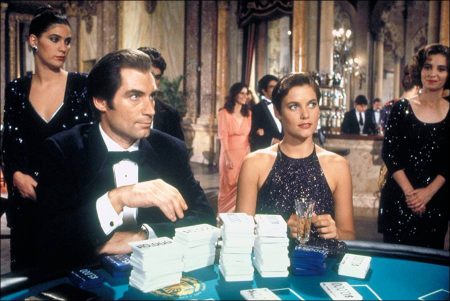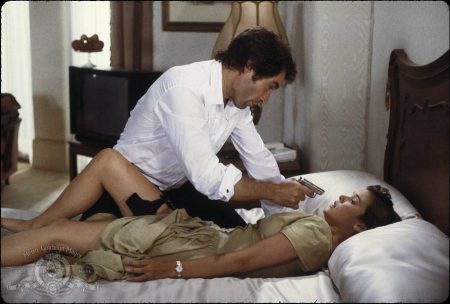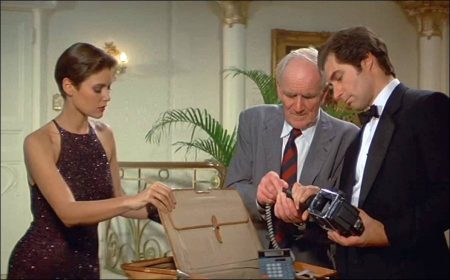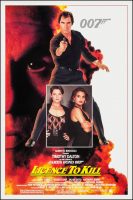Taglines: James Bond is out on his own and out for revenge.
Licence to Kill movie storyline. James Bond is attending the wedding of his friend, Felix Leiter, formerly of the CIA now DEA. When they’re on their way to the wedding, Felix’s associates tell him that Franz Sanchez, a sadistic drug lord, whom they’ve been trying to apprehend, is in the country. They decide to go get him. With Bond’s help they do. While in custody, Sanchez offers two million dollars to anyone who will help him escape.
While being transported, one of the men does that. Later Sanchez goes to Felix’s, kills his wife, and then literally throws Felix to the sharks. When Bond learns of this, he decides not to carry out his mission and instead goes after Sanchez. But when M learns of this, he has Bond’s license to kill revoked.
Bond then bolts and meets Pam Bouvier, one of Felix’s assets, and he hires her to get him to Sanchez’s country. He meets Sanchez under the guise of looking for work. When he makes his move someone captures him. They’re narcotics agents from another country, and when a British official tries to take him, Sanchez attacks them and when he sees Bond is a captive, he allows him into his inner circle.
Licence to Kill is a 1989 spy film and the sixteenth in the James Bond series produced by Eon Productions, and the last to star Timothy Dalton in the role of the fictional MI6 agent James Bond. Its story sees Bond being suspended from MI6 as he pursues drug lord Franz Sanchez, who has ordered an attack against his CIA friend Felix Leiter and the murder of Felix’s wife during their honeymoon.
Licence to Kill was the first film in the series to not use the title of an Ian Fleming story. Although its plotline is largely original, it contains elements of the Fleming novel Live and Let Die and the short story “The Hildebrand Rarity”, interwoven with a sabotage premise influenced by Akira Kurosawa’s film Yojimbo.
It was the fifth and final consecutive Bond film to be directed by John Glen, as well as the last to feature actors Robert Brown as M and Caroline Bliss as Miss Moneypenny, and the final Bond film to utilise the services of screenwriter Richard Maibaum, title designer Maurice Binder, and producer Albert R. Broccoli before Maibaum and Binder’s deaths in 1991, and Broccoli’s passing in 1996. Originally titled Licence Revoked in line with the plot, the name was changed during post-production due to American test audiences associating the term with driving.
Budgetary reasons resulted in Licence to Kill becoming the first Bond film to be shot entirely outside the United Kingdom: principal photography took place on location in Mexico and the US, while interiors were filmed at Estudios Churubusco instead of Pinewood Studios. The film earned over $156 million worldwide, and enjoyed a generally positive critical reception, with ample praise for the stunts, but attracted some criticism for its significantly darker tone than its predecessors, which carried into Dalton’s portrayal of the character.
About the Production
Principal photography ran from 18 July to 18 November 1988. Shooting began in Mexico, which mostly doubled for the fictional Republic of Isthmus: locations in Mexico City included the Biblioteca del Banco de Mexico for the exterior of El Presidente Hotel and the Casino Español for the interior of Casino de Isthmus whilst the Teatro de la Ciudad was used for its exterior. Villa Arabesque in Acapulco was used for Sanchez’s lavish villa, and the La Rumorosa Mountain Pass in Tecate was used as the filming site for the tanker chase during the climax of the film. Sanchez’s Olympiatec Meditation Institute was shot at the Otomi Ceremonial Center in Temoaya. Other underwater sequences were shot at the Isla Mujeres near Cancún.
In August 1988, production moved to the Florida Keys, notably Key West. Seven Mile Bridge towards Pigeon Key was used for the sequence in which the armoured truck transporting Sanchez, following his arrest, is driven off the edge. Other locations there included Ernest Hemingway House, Key West International Airport, Mallory Square, St. Mary’s Star of the Sea Church for Leiter’s wedding and Stephano’s House 707 South Street for his house and patio. The US Coast Guard Pier was used to film Isthmus City harbour. As production moved back to Mexico City, Broccoli became, marking the first time during the James Bond film series where he was not present during filming.
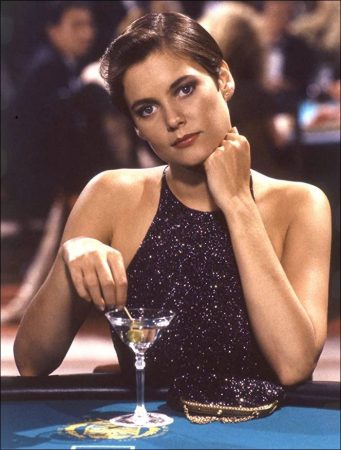
The scene where Sanchez’s plane is hijacked was filmed on location in Florida, with stuntman Jake Lombard jumping from a helicopter to a plane and Dalton himself being filmed atop the aircraft. The plane towed by the helicopter was a life-sized model created by special effects supervisor John Richardson. After filming wide shots of David Hedison and Dalton parachuting, closer shots were made near the church location.
During one of the takes, a malfunction of the harness equipment caused Hedison to fall on the pavement. The injury made him limp for the remainder of filming. The aquatic battle between Bond and the henchmen required two separate units, a surface one led by Arthur Wooster which used Dalton himself, and an underwater one which involved experienced divers. The barefoot waterskiing was done by world champion Dave Reinhart, with some close-ups using Dalton on a special rig. Milton Krest’s death used a prosthetic head which was created by John Richardson’s team based on a mould of Anthony Zerbe’s face. The result was so gruesome that it was shortened and toned down to avoid censorship problems.
For the climactic tanker chase, the producers used an entire section of a highway near Mexicali, which had been closed for safety reasons. Sixteen eighteen-wheeler tankers were used, some with modifications made by manufacturer Kenworth at the request of driving stunts arranger Rémy Julienne. Most were given improvements to their engines to run faster, while one model had an extra steering wheel on the back of the cabin so a hidden stuntman could drive while Carey Lowell was in the front and another received extra suspension on its back so it could lift its front wheels. Although a rig was constructed to help a rig tilt onto its side, it was not necessary as Julienne was able to pull off the stunt without the aid of camera trickery.
About the Music
Initially Vic Flick, who had played lead guitar on Monty Norman’s original 007 theme, and Eric Clapton were asked to write and perform the theme song to Licence to Kill and they produced a theme to match Dalton’s gritty performance, but the producers turned it down and instead Gladys Knight’s song and performance was chosen. The song (one of the longest to ever be used in a Bond film) was based on the “horn line” from “Goldfinger”, seen as an homage to the film of the same name, which required royalty payments to the original writers. The song gave Knight her first British top-ten hit since 1977. The end credits feature the Top 10 R&B hit “If You Asked Me To”, sung by Patti LaBelle.
John Barry was not available at the time due to throat surgery, so the soundtrack’s score was composed and conducted by Michael Kamen, who was known for scoring many action films at the time, such as Lethal Weapon and Die Hard. Glen said he picked Kamen, feeling he could give “the closest thing to John Barry.”
Licence to Kill (1989)
Directed by: John Glen
Starring: Timothy Dalton, Carey Lowell, Robert Davi, Benicio del Toro, Talisa Soto, Anthony Zerbe, Priscilla Barnes, David Hedison, Caroline Bliss, Frank McRae, Everett McGill
Screenplay by: Michael G. Wilson, Richard Maibaum
Production Design by: Peter Lamont
Cinematography by: Alec Mills
Film Editing by: John Grover
Costume Design by: Jodie Lynn Tillen
Set Decoration by: Michael Ford
Art Direction by: Dennis Bosher, Michael Lamont
Music by: Michael Kamen
MPAA Rating: PG-13 for action violence and drug content.
Distributed by: MGM / UA Communications Co. (United States), United International Pictures (International)
Release Date: June 13, 1989 (London), July 14, 1989 (United Kingdom / United States)
Visits: 332
